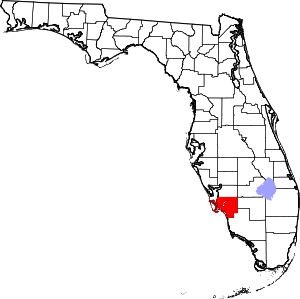Fort Myers, Florida
Fort Myers or Ft. Myers, is the county seat[6] and commercial center of Lee County, Florida, United States. As of the 2010 census, the population was 62,298 and in 2019 was estimated at 87,103.[4][7] Together with the larger and more residential Cape Coral, it anchors a metropolitan statistical area (MSA) which comprises Lee County and has a population of 770,577 in 2019.
Fort Myers, Florida | |
|---|---|
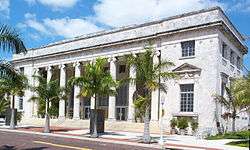 Sidney and Berne Davis Art Museum in downtown Fort Myers | |
| Nickname(s): "City of Palms" | |
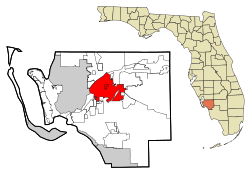 Location in Lee County, Florida | |
 Fort Myers, Florida Fort Myers  Fort Myers, Florida Fort Myers, Florida (the United States) | |
| Coordinates: 26°37′N 81°50′W[1] | |
| Country | United States |
| State | |
| County | Lee |
| Founded | March 24, 1885 |
| Government | |
| • Type | Council–manager |
| • Mayor | Randy Henderson Jr. |
| Area | |
| • Total | 49.04 sq mi (127.00 km2) |
| • Land | 39.84 sq mi (103.19 km2) |
| • Water | 9.20 sq mi (23.81 km2) |
| Elevation | 10 ft (3 m) |
| Population | |
| • Total | 62,298 |
| • Estimate (2019)[5] | 87,103 |
| • Density | 2,186.27/sq mi (844.13/km2) |
| Time zone | UTC−5 (Eastern (EST)) |
| • Summer (DST) | UTC−4 (EDT) |
| ZIP code(s) | 33900-33999 |
| Area code(s) | 239 |
| FIPS code | 12-24125[4] |
| GNIS feature ID | 0282700[3] |
| Website | cityftmyers.com |
Fort Myers is a gateway to the southwest Florida region and a major tourist destination within Florida. The winter estates of Thomas Edison ("Seminole Lodge") and Henry Ford ("The Mangoes") are major attractions.[8] The city is named after Colonel Abraham Myers, the quartermaster general of the Confederate States Army.[9][10]
History
Spain originally had colonial influence in Florida, succeeded by Great Britain and, lastly, the United States.
Seminole Wars
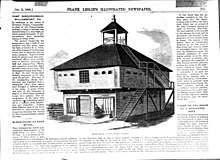
During the Second Seminole War, between 1835 and 1842, the U.S. Army operated Fort Dulany at Punta Rassa, at the mouth of the Caloosahatchee River. When a hurricane destroyed Fort Dulany in October 1841, army operations were moved up the Caloosahatchee River to a site named Fort Harvie.[11][12] Fort Harvie was abandoned in 1842, as the Second Seminole War wound down. After a white trader was killed by Seminoles on the Peace River in 1849, the Army returned to the Caloosahatchee River in 1850. The new Fort Myers was built on the burned ruins of Fort Harvie.[13] The fort was named for Brevet Colonel Abraham Charles Myers, quartermaster for the Army's Department of Florida. It covered about 139 acres (56 ha), and soon had 57 buildings, including a two-story blockhouse that was pictured in Frank Leslie's Illustrated Newspaper, and a 1,000-foot-long (300 m) wharf at which ships could dock. Irvin Solomon notes that Fort Myers was described "as 'one of the finest and largest' forts of the Seminole Wars". It was abandoned in 1858, at the end of the Third Seminole War.[14]
Civil War
During the American Civil War, Confederate blockade runners and cattle ranchers were based in Fort Myers. These settlers prospered through trading with the Seminole and Union soldiers.[15]
The United States Army set up a camp on Useppa Island, near the entrance to Charlotte Harbor, in December 1863. It was intended as a place from which to recruit Union sympathizers and Confederate deserters and conscription-evaders and to raid into the interior and interfere with Confederate efforts to round up cattle for supply to the Confederate Army. After some probes along the Peace and Myakka rivers, which had mixed results, operations were moved to the mainland.[16] Troops from the 47th Pennsylvania Infantry Regiment and the 2nd Regiment of Florida Rangers (later reorganized as the 2nd Florida Cavalry Regiment (Union)) left Key West for Fort Myers early in January 1864. The Union soldiers reached Fort Myers quickly enough to capture three Confederate sympathizers before they could act on orders to burn the fort to keep it out of Union hands. Beyond the principal reason for occupying the fort of providing support for Union sympathizers and local residents disaffected with Confederate taxation and conscription, the fort provided access to the large cattle herds in southern Florida, support for the blockade of the southwest Florida coast being conducted by the U.S. Navy, and a haven for any escaped slaves in the area.[17]
In April 1864, after the troops from the 47th Pennsylvania Infantry Regiment had been transferred to Louisiana, Companies D and I of the 2nd United States Colored Infantry Regiment were transferred from Key West to Fort Myers, and remained at the fort until it was abandoned.[18] Company G of the regiment had also been sent to Fort Myers by early May. [19] Solomon argues that Brevet Brigadier General Daniel Phineas Woodbury, commandant of the District of Key West and the Tortugas, intended that action to be an irritant to the Confederacy. The presence of the black soldiers, who made up the majority of troops used in raids into Confederate territory, played on Confederate fears of armed blacks. It was reported that Woodbury took pleasure in placing a "prickly pear cactus under the Confederate saddle".[20]
By the spring of 1864, Fort Myers was protected by a 500-foot-long (150 m) breastwork, 7 feet (2.1 m) high and 15 feet (4.6 m) wide, extending in an arc around the land side of the fort. The Seminole War-era blockhouse had been repaired and another two-story blockhouse built. The fort was soon harboring more than 400 civilians and Confederate army deserters. Many of the white men enlisted in the 2nd Florida Union Cavalry. Although designated as cavalry, the members of the regiment stationed at Fort Myers were never mounted. Escaped slaves that came to the fort were recruited into the 2nd United States Colored Infantry Regiment.[21]
The Union achieved control of the full length of the Mississippi River after the fall of Vicksburg in July 1863. The Confederate Army then became dependent on Florida for most of its supply of beef. By the end of 1863 between 1,000 and 2,000 head of cattle were being shipped to the Confederate Army from Florida every week.[22] As 1864 progressed, Union troops and sympathizers began driving cattle to Punta Rassa to supply Union ships on blockade duty and Union-held Key West, reducing the supply of cattle available to Confederate forces. The increased shipping from Punta Rassa led the Union Army to built a barracks and a wharf there.[23] By one Confederate estimate, the Union shipped 4,500 head of cattle from Punta Rassa.[24]
The Battle of Fort Myers was fought on February 20, 1865, in Lee County, Florida during the last months of the American Civil War. This small engagement is known as the "southernmost land battle of the Civil War."[25] (However, see Battle of Palmito Ranch.)
Settlement and founding
The Fort Myers community was founded after the American Civil War by Captain Manuel A. Gonzalez on February 21, 1866.[26][27] Captain Gonzalez was familiar with the area as a result of his years of service delivering mail and supplies to the Union Army at the fort during the Seminole Indian Wars and Civil War.[26][27] When the U.S. government abandoned the fort following the Civil War, Gonzalez sailed from Key West to found the community.[26][27][28] Three weeks later, Joseph Vivas and his wife, Christianna Stirrup Vivas, arrived with Gonzalez's wife, Evalina, and daughter Mary.[29]
Gonzalez settled his family near the abandoned Fort Myers, where he began the area's first trading post. He traded tobacco, beads, and gunpowder, and sold otter, bobcat, and gator hide to the neighboring Seminole.[15] A small community began to form around the trading post.
In the late 19th century, northerners began to travel to Florida in the winter. Some saw development opportunities. In 1881, the wealthy industrialist Hamilton Disston of Philadelphia, Pennsylvania came to the Caloosahatchee Valley. He planned to dredge and drain the Everglades for development. Diston connected Lake Okeechobee with the Caloosahatchee River; this allowed steamboats to run from the Gulf of Mexico to Lake Okeechobee and up the Kissimmee River.[15]
On August 12, 1885, the small town of Fort Myers—all 349 residents—was incorporated. At that time, it was the second-largest town on Florida's Gulf Coast south of Cedar Key.[30]
In 1885, inventor Thomas Alva Edison was cruising Florida's west coast and stopped to visit Fort Myers.[30] He soon bought 13 acres along the Caloosahatchee River in town. There he built his home "Seminole Lodge", as a winter retreat. It included a laboratory for his continuing work. After the lodge was completed in 1886, Edison and his wife, Mina, spent many winters in Fort Myers. Edison also enjoyed local recreational fishing, for which Fort Myers had gained a national reputation.[31]
In 1898, the Royal Palm Hotel was constructed. This luxury hotel attracted tourists and established Fort Myers nationally as a winter resort destination.[32]
20th century
On May 10, 1904, access to the Fort Myers area was greatly improved with the opening of the Atlantic Coast Line Railroad, connecting Punta Gorda to Fort Myers. This route provided Lee County both passenger and freight railroad service.[33]
In 1908, the Arcade Theater was constructed in downtown Fort Myers. Originally a vaudeville house, Edison viewed films here for the first time with friends Henry Ford and Harvey Firestone.[34] With the growth of the film industry, the Arcade Theatre was converted into a full movie house. A wall divided the stage in order to form two screening rooms. Changes in moviegoing habits since the late 20th century have led to the renovation of the theater for use again in live performance. It is now host to the Florida Repertory Theatre, a performing arts hall.
During World War I, Edison became concerned about America's reliance on foreign supplies of rubber. He partnered with tire producer Harvey Firestone, of the Firestone Tire and Rubber Company, and Henry Ford, of the Ford Motor Company, to try to find a rubber tree or plant that could grow quickly in the United States. He sought one that would contain enough latex to support his research endeavor. In 1927, the three men contributed $25,000 each, and created the Edison Botanic Research Corporation in an attempt to find a solution to this problem.[30] In 1928, the Edison Botanic Research Corporation laboratory was constructed. It was in Fort Myers that Edison conducted the majority of his research and planted exotic plants and trees. He sent results and sample rubber residues to West Orange, New Jersey, for further work at his large Thomas A. Edison "Invention Factory" (now preserved in the Thomas Edison National Historical Park). Through Edison's efforts, the royal palms lining Riverside Avenue (now McGregor Boulevard) were imported and planted. They inspired Fort Myers' nickname as "City of Palms".[30]
After testing 17,000 plant samples, Edison eventually discovered a source in the plant Goldenrod (Solidago leavenworthii). The rubber project was transferred to the United States Department of Agriculture five years later.[30]
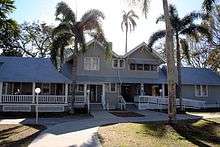
In 1916, automobile magnate Ford purchased the home next to Edison's from Robert Smith of New York. Ford named his estate "the Mangoes". Ford's craftsman-style "bungalow" was built in 1911 by Smith. Ford, Firestone, and Edison were leaders in American industry and part of an exclusive group titled "the Millionaires' Club". The three men have been memorialized in statues in downtown Fort Myers' Centennial Park.
In 1924, with the beginning of construction of the Edison Bridge, named for Edison, the city's population steadily grew. The bridge was opened on February 11, 1931, the 84th birthday of its namesake. Edison dedicated the bridge, and was the first to drive across it.
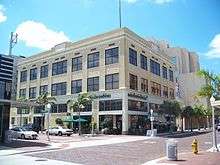
In the decade following the bridge's construction, the city had a real estate boom. Several new residential subdivisions were built beyond downtown, including Dean Park, Edison Park, and Seminole Park.[31] Edison Park, located across McGregor Boulevard from the Edison and Ford properties, includes a number of Fort Myers' most stately homes. The historic development showcases a variety of architectural styles. In the 21st century, it is known for its community activities and strong neighborhood ties.[35]
In 1947, Mina Edison deeded Seminole Lodge to the city of Fort Myers, in memory of her late husband and for the enjoyment of the public. By 1988, the adjacent Henry Ford winter estate was purchased by the city and opened for public tours in 1990. The combined properties today are known as the Edison and Ford Winter Estates.
Geography and climate
According to the United States Census Bureau, the city has a total area of 40.4 square miles (105 km2), of which 31.8 square miles (82 km2) is land and 8.6 square miles (22 km2) (21.25%) is water.
Fort Myers is on the border between a tropical savanna climate and a humid subtropical climate.[36]
The temperature rarely rises to 100 °F (38 °C) or lowers to the freezing mark.[37] Rainfall averages just over 56 inches per year, strongly concentrated during the rainy season (June to September) with its frequent showers and thunderstorms; on average, these four months deliver 68 percent of annual rainfall. From October to May, average monthly rainfall is less than three inches. In years with drier than average conditions from winter into mid-spring, drought can develop, and brush fires can be a significant threat. Reflecting the June to September wet season, Fort Myers has 89 days annually in which a thunderstorm is close enough for thunder to be heard, the most in the nation.[38]
The monthly daily average temperature ranges from 64.5 °F (18.1 °C) in January to 83.4 °F (28.6 °C) in August, with the annual mean being 75.1 °F (23.9 °C).
Records range from 24 °F (−4 °C) on December 29, 1894 up to 103 °F (39 °C) on June 16–17, 1981.[37]
| Climate data for Fort Myers, Florida (Page Field), 1981–2010 normals,[lower-alpha 1] extremes 1892–present | |||||||||||||
|---|---|---|---|---|---|---|---|---|---|---|---|---|---|
| Month | Jan | Feb | Mar | Apr | May | Jun | Jul | Aug | Sep | Oct | Nov | Dec | Year |
| Record high °F (°C) | 88 (31) |
92 (33) |
94 (34) |
96 (36) |
99 (37) |
103 (39) |
101 (38) |
100 (38) |
98 (37) |
95 (35) |
95 (35) |
91 (33) |
103 (39) |
| Mean maximum °F (°C) | 88 (31) |
91 (33) |
93 (34) |
90.8 (32.7) |
94.7 (34.8) |
96.3 (35.7) |
96.2 (35.7) |
95.6 (35.3) |
94.1 (34.5) |
91.8 (33.2) |
88.2 (31.2) |
84.9 (29.4) |
97.2 (36.2) |
| Average high °F (°C) | 75 (24) |
77 (25) |
80 (27) |
85 (29) |
89 (32) |
92 (33) |
92 (33) |
92 (33) |
91 (33) |
87 (31) |
81 (27) |
77 (25) |
84.7 (29.3) |
| Average low °F (°C) | 54 (12) |
56 (13) |
59 (15) |
63 (17) |
69 (21) |
74 (23) |
75 (24) |
75 (24) |
74 (23) |
69 (21) |
62 (17) |
56 (13) |
65.5 (18.6) |
| Mean minimum °F (°C) | 37.0 (2.8) |
40.0 (4.4) |
44.9 (7.2) |
51.7 (10.9) |
60.8 (16.0) |
68.5 (20.3) |
71.3 (21.8) |
71.9 (22.2) |
69.8 (21.0) |
57.3 (14.1) |
48.9 (9.4) |
40.0 (4.4) |
34.5 (1.4) |
| Record low °F (°C) | 27 (−3) |
27 (−3) |
33 (1) |
39 (4) |
50 (10) |
58 (14) |
66 (19) |
65 (18) |
63 (17) |
45 (7) |
34 (1) |
24 (−4) |
24 (−4) |
| Average rainfall inches (mm) | 1.94 (49) |
2.15 (55) |
2.88 (73) |
2.18 (55) |
2.65 (67) |
10.09 (256) |
9.04 (230) |
10.14 (258) |
8.31 (211) |
2.88 (73) |
1.96 (50) |
1.71 (43) |
55.93 (1,421) |
| Average rainy days (≥ 0.01 in) | 5.5 | 5.2 | 6.2 | 4.2 | 6.8 | 16.0 | 17.6 | 17.9 | 15.4 | 6.8 | 4.4 | 4.5 | 110.5 |
| Source: NOAA[37][39] | |||||||||||||
Demographics
| Historical population | |||
|---|---|---|---|
| Census | Pop. | %± | |
| 1890 | 575 | — | |
| 1900 | 943 | 64.0% | |
| 1910 | 2,463 | 161.2% | |
| 1920 | 3,678 | 49.3% | |
| 1930 | 9,082 | 146.9% | |
| 1940 | 10,604 | 16.8% | |
| 1950 | 13,195 | 24.4% | |
| 1960 | 22,523 | 70.7% | |
| 1970 | 27,351 | 21.4% | |
| 1980 | 36,638 | 34.0% | |
| 1990 | 45,206 | 23.4% | |
| 2000 | 48,208 | 6.6% | |
| 2010 | 62,298 | 29.2% | |
| Est. 2019 | 87,103 | [5] | 39.8% |
| source:[40] | |||
| Fort Myers Demographics | |||
|---|---|---|---|
| 2010 Census | Fort Myers | Lee County | Florida |
| Total population | 62,298 | 618,754 | 18,801,310 |
| Population, percent change, 2000 to 2010 | +29.2% | +40.3% | +17.6% |
| Population density | 1,559.1/sq mi | 788.7/sq mi | 350.6/sq mi |
| (Non-Hispanic White or Caucasian) | 54.6% | 53.9% | 57.9% |
| Black or African-American | 32.3% | 18.3% | 16.0% |
| Hispanic or Latino (of any race) | 20.0% | 20.4% | 22.5% |
| Asian | 1.6% | 1.4% | 2.4% |
| Native American or Native Alaskan | 0.6% | 0.4% | 0.4% |
| Pacific Islander or Native Hawaiian | 0.1% | 0.1% | 0.1% |
| Two or more races (Multiracial) | 2.8% | 2.1% | 2.5% |
| Other races | 8.0% | 4.7% | 3.6% |
The population of Fort Myers was 62,298 at the 2010 census.[41] Between the 2000 census and 2010 census, the city's population increased at a rate of 29.2 percent.
Fort Myers is one of two cities that make up the Cape Coral-Fort Myers Metropolitan Statistical Area. The 2010 population for the metropolitan area was 618,754.[41]
The population of Lee County, Florida and the Cape Coral-Fort Myers Metropolitan Statistical Area has grown 40.3 percent since the census in 2000, much faster than the average growth rate of 17.6 percent experienced throughout the State of Florida.
Government
Fort Myers has a council–manager government in which the city council consists of a mayor and six council members. The city council is responsible for establishing policy, passing local ordinances, voting appropriations, and developing an overall vision for the city. The mayor is elected by registered voters city-wide. The mayor of Fort Myers is Randy Henderson Jr. Council members are elected by registered voters in their ward and represent that particular ward for a four-year term. A council member must reside in the ward from which he or she is elected.[42]
Policing of Fort Myers is performed by the Fort Myers Police Department.
Education
Secondary schools
See: Lee County School District for other public schools in the area.
- Secondary schools in the city include:
- Dunbar High School
- Fort Myers Senior High School, an International Baccalaureate school
- Bishop Verot High School, a private, Roman Catholic high school in Fort Myers, operated by the Diocese of Venice, Florida
Higher education
Institutions of higher learning in the city include:
- Hodges University
- Keiser University[43]
- Nova Southeastern University[44]
- Rasmussen College[45]
- Southern Technical College
- Fort Myers Technical College[46]
Libraries
Library Services include:
- Fort Myers Regional Library: The Fort Myers Regional Library is the hub for the Lee County Library System, holding the main collections of legal, business, news, and financial information. The library is located in downtown Fort Myers.[47]
- Dunbar-Jupiter Hammon Public Library: The library opened on October 7, 1974. The founders named the library in honor of the first African poet to have his work published. Dunbar, the community's name, was added at the request of its residents. The library was moved in 1996 to its current location on Blount Street. It is home to the largest African-American book collection in southwest Florida.[48]
Sports
The City of Palms Classic is an annual high school basketball tournament held in Fort Myers since 1973. Several of its alumni have made it to the NBA. The city is also home to the Fort Myers Mighty Mussels minor league baseball team, a Class-A affiliate of the Minnesota Twins.
Points of interest
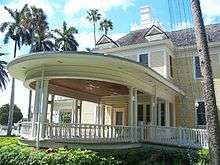
- The Calusa Nature Center and Planetarium[49] is a private, not-for-profit, environmental education organization. Set on a 105-acre (0.42 km2) site, it has a museum, three nature trails, a planetarium, butterfly and bird aviaries, a gift shop and meeting and picnic areas.
- City of Palms Park, former home of the Boston Red Sox spring training program, close to downtown Fort Myers
- Edison and Ford Winter Estates
- Edison Mall
- Historic Downtown, waterfront entertainment district
- Murphy-Burroughs House
- Imaginarium Science Center
- Southwest Florida Museum of History
Public transportation
Airports
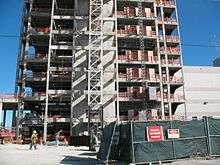
The Fort Myers metropolitan area is served by two nearby airports. Southwest Florida International Airport (RSW) is located southeast of the city. The airport, which sits on 13,555 acres of land, is the 45th busiest airport (by annual passengers). In 2018 the airport served 9,373,178 passengers. Page Field is a small general aviation airport whose primary traffic consist of smaller aircraft.
Fort Myers in popular culture
In film
- The abandoned city scene with the Edison Theatre, from the movie Day of the Dead (1985) was filmed in downtown Fort Myers.[51]
- Some courthouse and other "city" scenes in Just Cause (1995) were filmed in downtown Ft. Myers.[52]
- Part of the independent film Trans (1999) was filmed in Fort Myers.[53]
In print
- Fort Myers is part of the setting of Red Grass River: A Legend (1998), a novel by James Carlos Blake.[54]
Notable people
Present
- Nate Allen - safety for Miami Dolphins
- Haley Bennett - actress
- Jason Bartlett - Tampa Bay Rays shortstop
- Bob Beamon - track and field athlete, gold medalist in 1968 Summer Olympics long jump, world record holder 1968 to 1991
- Bert Blyleven – Hall of Fame pitcher for Minnesota Twins, Texas Rangers, Pittsburgh Pirates, Cleveland Indians and California Angels[55]
- James Carlos Blake - author and former faculty member of Edison Community College
- Phillip Buchanon – cornerback for the Washington Redskins, Tampa Bay Buccaneers, Houston Texans, Oakland Raiders[56]
- Stacy Carter – former WWE wrestler[57]
- Stew Cliburn - Baseball player and coach.[58]
- Terrence Cody – nose tackle for Baltimore Ravens[59]
- Casey Coleman - former pitcher for Chicago Cubs [60]
- Bill Davey – professional bodybuilder[61]
- Noel Devine – running back for CFL's Montreal Alouettes[62]
- Richard Fain - former NFL player
- Earnest Graham – NFL running back, Tampa Bay Buccaneers
- Mike Greenwell – former Boston Red Sox left fielder and NASCAR driver[63]
- Mario Henderson – offensive tackle, Oakland Raiders[64]
- Nolan Henke – professional golfer[65]
- Anthony Henry – cornerback, Detroit Lions, Dallas Cowboys, Cleveland Browns
- Adam Johnson - former pitcher for Minnesota Twins[66]
- Tarah Kayne - figure skater, 2016 national champion
- Jevon Kearse – defensive end, Philadelphia Eagles, Tennessee Titans
- Terri Kimball – Playboy Playmate of the Month for May 1964[67]
- Derek Lamely - professional golfer[68]
- Craig Leon – music and visual producer of the Ramones, Blondie, Luciano Pavarotti, Joshua Bell
- George McNeill - professional golfer
- Peter Mellor - English-born American footballer and coach
- Terry-Jo Myers - professional golfer, winner of three LPGA Tour tournaments[69]
- Seth Petruzelli – professional MMA fighter[70]
- Plies (Algernod Lanier Washington) – rapper[71]
- Lennie Rosenbluth (born 1933) - college and NBA basketball player
- Deion Sanders – Hall of Fame NFL cornerback for six teams, inducted to Pro Football Hall of Fame as a Dallas Cowboy, and Major League Baseball outfielder for five teams[72]
- Peggy Schoolcraft – professional bodybuilder, 1997 NPC Team Universe Champion[73][74]
- Chad Senior - two-time Olympian (Sydney Australia, 2000 - Athens Greece, 2004), competed in pentathlon
- Vonzell Solomon – American Idol third-place finisher[75]
- Greg Spires- former NFL player[76]
- Elissa Steamer – professional skateboarder
- Dan Vogelbach - MLB player
- Jaylen Watkins – safety for Los Angeles Chargers
- Sammy Watkins - wide receiver for Buffalo Bills, Los Angeles Rams, Kansas City Chiefs
- Tommy Watkins – former Minnesota Twins baseball player[77]
- Jeremy Ware - cornerback for Oakland Raiders[78]
- Walt Wesley – professional basketball player (1966–1976) for Cincinnati Royals and six other NBA teams[79]
- Cliff Williams – bass player for AC/DC
- Julio Zuleta – former first baseman for Chicago Cubs
Past
- Verna Aardema - children's book author
- G. Harold Alexander - Florida Republican Party state chairman, c. 1952-1964
- Patty Berg – Hall of Fame golfer, one of LPGA's founders
- Gerard Damiano – adult film director
- Thomas Edison – improved and perfected the incandescent light bulb and audio recording methods, had a winter estate next to Henry Ford's
- Harvey Firestone – founded Firestone Tire Company, had a winter estate near Edison and Ford's homes[80]
- Henry Ford – founded the Ford Motor Company, and father of the assembly line, had a winter estate next to Thomas Edison's
- Charles Ghigna – poet and children's author known as "Father Goose;" boyhood home 1950-1973
- Sara Hildebrand – United States Olympic diver (2000, 2004)[81]
- Andrew Jacobson (born 1985) - Major League Soccer player
- Jerry Lawler – WWE wrestler and announcer[57]
- Denise Masino – professional bodybuilder
- Mindy McCready – country music artist[82]
- Norma Miller – Lindy Hop dancer, choreographer, actress, author, and comedian known as the Queen of Swing
- Diamond Dallas Page – former WCW and WWE wrestler, actor
- Kimberly Page – former member of the WCW Nitro Girls and Playboy model
- Charles Rogers- Former NFL running back
- Marius Russo - professional baseball player
- Walt Wesley - professional basketball player
Sister cities
Fort Myers has a sister city agreement with:
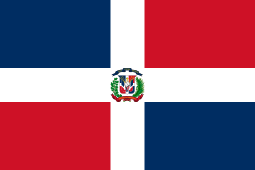
References
- Mean monthly maxima and minima (i.e. the expected highest and lowest temperature readings at any point during the year or given month) calculated based on data at said location from 1981 to 2010.
- "US Gazetteer files: 2010, 2000, and 1990". United States Census Bureau. February 12, 2011. Retrieved April 23, 2011.
- "2019 U.S. Gazetteer Files". United States Census Bureau. Retrieved July 2, 2020.
- "US Board on Geographic Names". United States Geological Survey. October 25, 2007. Retrieved 2008-01-31.
- "American FactFinder". United States Census Bureau. Retrieved September 11, 2018.
- "Population and Housing Unit Estimates". United States Census Bureau. May 24, 2020. Retrieved May 27, 2020.
- "Find a County". National Association of Counties. Archived from the original on May 31, 2011. Retrieved June 7, 2011.
- "Population and Housing Unit Estimates". Retrieved May 21, 2020.
- "Southwest Florida Visitor Center". Swflvisitor.com. Retrieved November 17, 2017.
- "The History of Downtown Fort Myers". Downtown Fort Myers. Archived from the original on December 25, 2010. Retrieved December 26, 2010.
- Gannett, Henry (1905). The Origin of Certain Place Names in the United States. Govt. Print. Off. pp. 129.
- McCarthy, Kevin M. (2014). Caloosahatchee River Guidebook. Rowman & Littlefield. ISBN 9781561646531.
- Dibble, Ernest F. (Fall 1999). "Giveaway Forts: Territorial Forts and the Settlement of Florida". The Florida Historical Quarterly. 78 (2): 207–233. JSTOR 30149384.
- Sustar, Pamela (2008). Historic Lee County: The Story of Fort Myers & Southwest Florida. San Antonio, Texas: Historical Publishing Network. pp. 9–10. ISBN 9781893619876. Retrieved January 15, 2019.
- Solomon 1993, pp. 129–32.
- "Fort Myers Florida History". Fortmyers-online.com. Retrieved November 17, 2017.
- Dillon 1984, pp. 317–19, 324–25.
- Solomon 1993, pp. 133, 134, 136.
- Solomon 1993, pp. 133–34.
- Buker 1993, p. 139.
- Solomon 1993, pp. 133–34, 143.
- Solomon 1993, pp. 136–37, 160.
- Solomon 1993, pp. 140–141.
- Dillon 1984, p. 329.
- Buker 1993, p. 160.
- "02, February in Florida History". Florida Historical Society. Archived from the original on October 14, 2011. Retrieved June 18, 2010.
- "Founder's kin converge at City of Palms". News-press.com. Retrieved November 17, 2017.
- "Exclusive: History Uncovered along Fort Myers Riverfront". News-Press. June 5, 2012. Archived from the original on June 30, 2013. Retrieved April 17, 2013.
- "Influential Local Capt. Manuel Gonzalez /Archived copy". July 29, 2009. Archived from the original on June 29, 2013. Retrieved April 17, 2013.
- "The History of Fort Myers - Greater Fort Myers Chamber of Commerce". Fortmyers.org. Retrieved November 17, 2017.
- "History of Ft Myers". Myriverdistrict.com. Retrieved November 17, 2017.
- Technology, Florida Center for Instructional. "Royal Palm Hotel in Fort Myers". Fcit.usf.edu. Retrieved November 17, 2017.
- Turner, Gregg M. A Journey Into Florida Railroad History. University Press of Florida, p. 156. ISBN 978-0-8130-3233-7
- "Arcade Theater in Fort Myers, FL - Cinema Treasures". cinematreasures.org. Retrieved November 17, 2017.
- McGregor history, Fort Myers Online
- Randolph J. Widmer; Randolph A. Widmer (1988). The Evolution of Calusa: A Nonagricultural Chiefdom of the Southwest Florida Coast. University of Alabama Press. pp. 99. ISBN 978-0-8173-0358-7.
Trewatha (1943) originally placed the northernmost boundary [of Koppen zone Aw] along the 27th latitute, a line from Ft. Myers to Melbourne...
- "NowData - NOAA Online Weather Data". National Oceanic and Atmospheric Administration. Retrieved 2019-06-20.
- "Weather Variety - Annual Days With Thunderstorms". Weatherpages.com. Archived from the original on 2012-02-20. Retrieved 2012-06-12.
- "Station Name: FL FORT MYERS PAGE FIELD AP". National Oceanic and Atmospheric Administration. Retrieved 2019-06-20.
- "Census Of Population And Housing". U.S. Census Bureau. Retrieved 2014-09-19.
- "U.S. Census website". Census.gov. Retrieved November 13, 2014.
- "City Council". City of Fort Myers. Retrieved December 2, 2019.
- "Keiser University- Ft. Myers". Keiser University. Retrieved April 3, 2010.
- "NSU Campus info". Nova Southeastern University. Retrieved August 3, 2011.
- "Rasmussen College- Ft. Myers campus". Retrieved June 25, 2010.
- Logan, Casey (June 8, 2015). "Fort Myers, Cape Coral technical institutes now colleges". News-Press. Retrieved June 9, 2015.
- "Dunbar Jupiter Hammon Public Library". Leegov.com. Archived from the original on April 13, 2016. Retrieved April 20, 2016.
- "Welcome to Calusa Nature Center & Planetarium". Calusanature.com. Retrieved June 12, 2012.
- "LeeTran". Lee County Southwest Florida. Retrieved November 17, 2017.
- Stetson, Nancy (September 7, 2011). "STARRING SW FLORIDA". Florida Weekly. Archived from the original on July 27, 2014. Retrieved July 25, 2014.
- "Production Credits - The Beaches of Fort Myers & Sanibel". Fortmyers-sanibel.com. Retrieved November 17, 2017.
- "Filmed in Fort Myers - Film Fort Myers" (PDF). Filmfortmyers.com. Archived from the original (PDF) on 4 August 2016. Retrieved November 17, 2017.
- James Carlos Blake (1998). Red Grass River: A Legend. New York: Avon.
- "Broadcasters | twinsbaseball.com: Team". Mlb.mlb.com. Retrieved 2010-07-29.
- Nobles, Charlie (November 27, 2001). "COLLEGES; Hurricanes' Buchanon Might Be the Best of the Best". The New York Times. Retrieved April 2, 2010.
- Lawler, Jerry (2002). It's Good to be the King...Sometimes. World Wrestling Entertainment. ISBN 978-0-7434-5768-2.
- Stew Cliburn at Society for American Baseball Research
- "'Bama's mountain of a nosetackle: 365-pound Terrence Cody". CNN. September 25, 2008. Retrieved April 2, 2010.
- "Casey Coleman Stats". Baseball Almanac. Retrieved November 26, 2012.
- "Pro Profiles - Bill Davey Pro Bodybuilding Profile". Bodybuilders.com. 1966-07-20. Archived from the original on 2014-07-15. Retrieved 2010-07-29.
- Peek into inner circle shows Noel Devine's no deviant Archived October 2, 2007, at the Wayback Machine, August 28, 2006
- Mark Aumann, NASCAR.COM (2006-05-17). "Ex-ballplayer Greenwell to make Truck debut - May 17, 2006". Nascar.Com. Retrieved 2010-07-29.
- "Mario Henderson". Nfl.com. 1984-10-29. Retrieved 2010-07-29.
- "Nolan Henke - Golf - CBSSports.com PGA". Cbssports.com. Retrieved 2010-07-29.
- "Adam Johnson Stats - Baseball-Reference.com". Baseball-Reference.com. Retrieved November 17, 2017.
- "Terri Kimball - Terri Kimball Nude - Terri Kimball Pics". Playboy.com. 2009-01-27. Archived from the original on 2010-01-17. Retrieved 2010-07-29.
- "Derek Lamely". PGA Tour. Archived from the original on October 19, 2012. Retrieved November 26, 2012.
- LPGA Tour profile for Terry-Jo Myers Archived June 29, 2011, at the Wayback Machine
- Wetzel, Dan. "Final curtain for the Kimbo show - UFC - Yahoo! Sports". Sports.yahoo.com. Retrieved 2010-07-29.
- "Warner Music Canada - Plies". Warnermusic.ca. Archived from the original on June 7, 2011. Retrieved 2010-07-29.
- "ESPN.com: Where Sanders goes, teams win". Espn.go.com. 1967-08-09. Retrieved 2010-07-29.
- "Peggy Schoolcraft IFBB Pro Bodybuilder". Bodybuilding.com. October 9, 2002. Retrieved 8 September 2011.
- "2001 Ms. International results". Getbig.com. March 2, 2001. Retrieved 8 September 2011.
- "Vonzell Solomon". American Idol. Retrieved 2010-07-29.
- "In-Spires". Naplesnews.com. Retrieved November 17, 2017.
- Lisa Winston (2010-02-15). "Article | MiLB.com News | The Official Site of Minor League Baseball". Web.minorleaguebaseball.com. Retrieved 2010-07-29.
- "Jeremy Ware Stats - Pro-Football-Reference.com". Pro-Football-Reference.com. Retrieved November 17, 2017.
- "Walt Wesley NBA & ABA Statistics". Basketball-Reference.com. Retrieved 2010-07-29.
- "Florida: Edison Pageant of Light (Local Legacies: Celebrating Community Roots - Library of Congress)". Lcweb2.loc.gov. Retrieved 2010-07-29.
- "Hildebrand Hired as First Diving Coach at Florida Gulf Coast". Swimming World. August 31, 2006. Retrieved 2 March 2018.
- "Singer Mindy McCready taken into custody". USA Today. July 26, 2007. Retrieved May 2, 2010.
Sources
- Buker, George E. (1993). Blockaders, Refugees, & Contrabands: Civil War on Florida's Gulf Coast, 1861-1865. Tuscaloosa, Alabama: The University of Alabama Press. ISBN 0-8173-1296-X.
- Dillon, Rodney E., Jr. (January 1984). ""The Little Affair": The Southwest Florida Campaign, 1863–1864". The Florida Historical Quarterly. 62 (3): 314–31. JSTOR 30146289.
- Solomon, Irvin D. (October 1993). "Southern Extremities: The Significance of Fort Myers in the Civil War". The Florida Historical Quarterly. 72 (2): 129–152. JSTOR 30148691.
